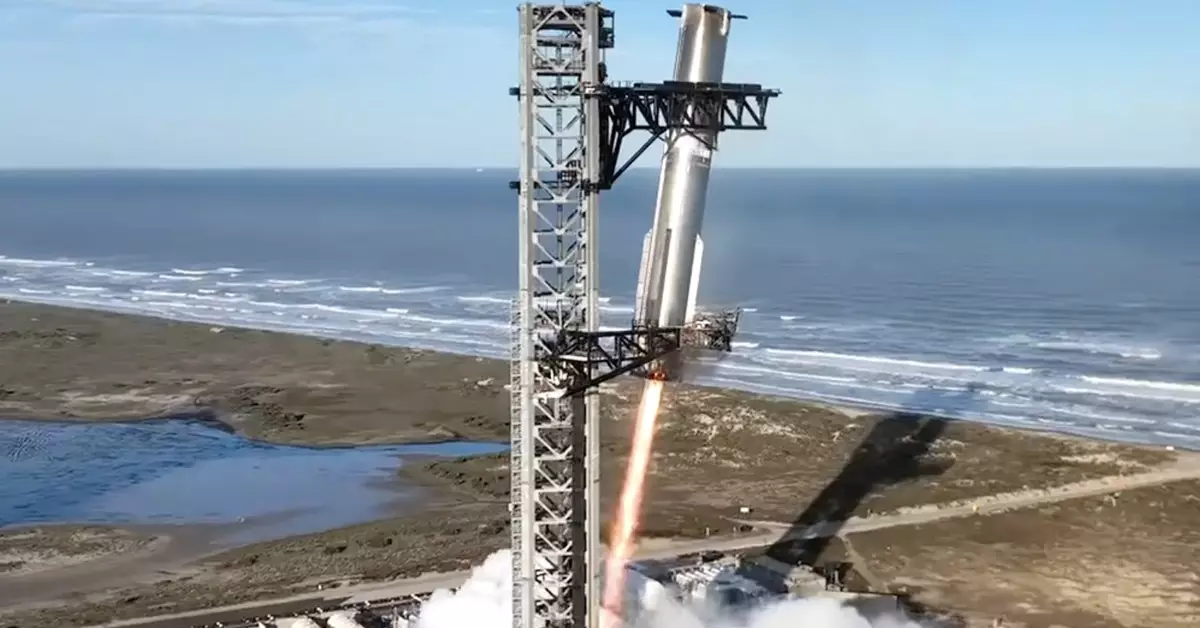The latest test flight of SpaceX’s Starship encapsulated the spirit of innovation and ambition that has characterized the company’s missions. On its seventh outing from Boca Chica, Texas, the Starship spacecraft was mounted atop the Super Heavy booster, a colossal vehicle standing at 403 feet, making it the largest launch vehicle ever created. This test aimed not only to advance the vehicle’s reliability and performance but also to explore the boundaries of rocket technology. However, as is common in aerospace endeavors, the flight was filled with both impressive successes and notable setbacks.
In a remarkable display of engineering prowess, SpaceX managed to successfully catch the Super Heavy booster using the launch tower’s uniquely designed “chopstick” arms. This marked a significant milestone for the SpaceX program, improving upon previous attempts. Nevertheless, amidst this triumph, a critical failure emerged when communication with the Starship spacecraft was lost shortly after its ascent. Kate Tice, a prominent figure at SpaceX, revealed that during the ascent phase, multiple engines failed, resulting in the assumption that the spacecraft was lost. Such vulnerable moments highlight the inherent risks involved in cutting-edge aerospace projects.
After the test flight, SpaceX stated that Starship experienced a “rapid unscheduled disassembly” during its ascent burn. Investigators are now meticulously analyzing flight data to uncover the root cause of the failure. This incident serves as a clear reminder of the complexities involved in aerospace engineering, especially when testing new technologies and materials. The mission had incorporated several major improvements, including a redesigned propulsion system, an upgraded flight computer, and a new heat shield featuring various metallic tiles along with a cooling system. The introduction of these technological enhancements aims to bolster both performance and safety, but it also raises questions about the stress-testing methods used during the flight.
The dramatic nature of the Starship’s re-entry captured public interest, particularly as several spectators in Turks and Caicos reported seeing debris from the Craft’s descent. Posting videos on social media, these individuals highlighted the growing connection between space missions and public engagement. Social media now serves not just as a platform for sharing news but as an interactive space where the public can witness and participate in space exploration narratives.
SpaceX promises that the latest version of Starship incorporates significant upgrades aimed at enhancing performance. The Super Heavy booster utilized engines that had been previously flown, emphasizing the reusability aspect that SpaceX champions. This approach not only aims to reduce costs but also to streamline the flight process. Additionally, the collaboration of the spacecraft and booster allows them to carry both crew and cargo into orbit effectively. However, the flight also revealed the challenging nature of testing resilience, as certain tiles were purposefully removed to assess their vulnerability—a potentially risky undertaking.
The outcome of this test flight presents a dual narrative of success and failure; while SpaceX made strides in catching the Super Heavy booster and tested new technologies, the loss of the Starship spacecraft underscores the potential dangers and challenges in space travel. As SpaceX reviews its data and learns from this experience, the company is likely to iterate its designs, maximize safety measures, and enhance the fundamental goals that drive its mission of making life multi-planetary. The company’s continued evolution reflects its dedication to pushing boundaries while acknowledging the risks that are intrinsic to pioneering aerospace technology.
The saga of SpaceX’s Starship is a testament to the relentless pursuit of innovation in the realm of space exploration. While setbacks highlight the arduous journey of achieving success, they also provide invaluable learning opportunities that can inform the future of ambitious aerospace projects. As the landscape of space travel continues to develop, SpaceX remains at the forefront, eager to tackle the challenges ahead.


Leave a Reply